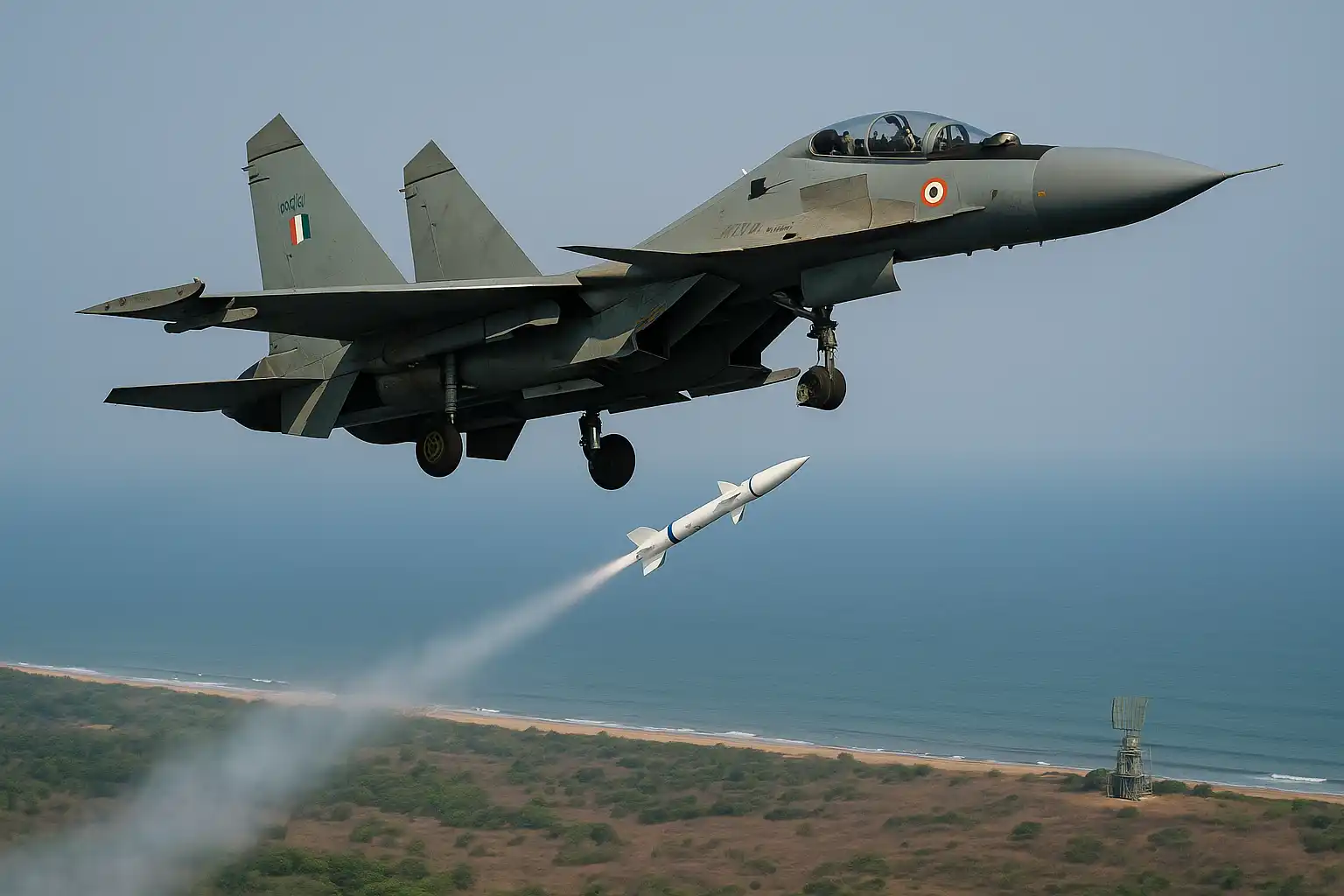It was just after sunrise on a calm July morning in 2025, off the coast of Odisha. A Su-30MKI roared across the sky, but this flight wasn’t routine. Beneath its wing was something that would mark a new era in India’s air combat capabilities: the Astra BVRAAM Indigenous RF Seeker.
When the missile launched and vanished into the horizon, it wasn’t just a test. It was a statement.
For those of us who’ve followed India’s defence journey, this moment felt different. It wasn’t only about hitting a target; it was about striking self-reliance with surgical precision. This successful DRDO–IAF flight trial didn’t just validate a weapon system. It signalled India’s entry into the elite league of air-to-air missile developers worldwide.
India’s Astra BVRAAM with Indigenous RF Seeker: A Missile Milestone
The Astra Beyond Visual Range Air-to-Air Missile (BVRAAM) is India’s first fully indigenous missile designed to engage enemy aircraft beyond 100 km. As a beyond visual range air-to-air missile, it enhances the IAF’s ability to neutralise threats long before visual contact.
At the heart of this test was not just the missile’s range or speed, but the indigenous brain guiding it: the DRDO missile seeker technology. The seeker enables autonomous targeting and destruction during the missile’s terminal phase, a capability long monopolised by a few nations.
Astra Missile Test July 2025: A Defining Trial
The IAF missile test 2025 involved launching two Astra Mk1 missiles with RF seeker from Su-30MKI platforms. Both engaged high-speed aerial targets, demonstrating pinpoint accuracy and reliability.
This wasn’t just about the missile; it validated DRDO’s weapon system development, showcasing seamless coordination between guidance, propulsion, and terminal homing. It also displayed robust missile terminal phase tracking, a key capability against agile targets.
This test reinforced DRDO’s indigenous seeker development, placing India among global leaders in seeker-enabled missile systems.
Technical Edge: Indigenous Seeker and Fire-and-Forget Missile Guidance
The indigenous RF seeker provides fire-and-forget missile capability. Once locked, the missile autonomously tracks the target with no need for pilot intervention. This level of missile guidance and navigation boosts survivability in modern combat.
Why It’s Special:
- Fully designed and developed in India
- Works in all-weather, all-altitude conditions
- Defeats electronic jamming and decoys
- Compact enough for future variants
This seeker transforms Astra into a truly radar-guided missile India can call its own, enhancing the country’s air dominance missile profile.
Astra Missile from Su-30MKI: Platform and Performance
The Astra missile launch from Su-30MKI showcases its adaptability with India’s frontline aircraft. Su-30MKI’s missile capability was proven again as the platform successfully engaged simulated threats in real-time.
With further integration underway, Astra is being adapted for other platforms like Tejas Mk1A, Mirage-2000, and Rafale. This seamless Astra missile integration with Tejas Mk1A signifies India’s future-ready approach to air combat.
Indigenous Defence Technology India: Strategic Implications
This success shows that India’s journey toward missile self-reliance is no longer a goal; it’s something we’re finally living and building with confidence.
Backed by more than 50 Indian industries, including BEL and HAL, this project showcases India’s defence manufacturing strength. It is also aligned with the goals of Aatmanirbhar Bharat and supports the emerging Indian missile export policy.
With Astra now proven, export interest from friendly nations is expected to grow, further validating the Astra missile export potential.
What’s Next: Astra Mk2 and Astra Mk3 Development
Following the success of Astra Mk1, DRDO is accelerating the DRDO air-to-air missile roadmap, with Mk2 and Mk3 already under development.
Astra Mk2 Missile Range and Features:
- Extended range of 160+ km
- Dual-pulse propulsion
- Improved ECM resistance
- Precision seeker control in high-G scenarios
Astra Mk3:
- Under R&D with ramjet propulsion
- Aims to rival global systems like the Meteor missile
These upgrades will define India’s BVRAAM capability 2025 and beyond, supporting multi-layered aerial engagement.
Astra vs Global Competitors: Meteor Missile vs Astra
Here’s how Astra stacks up against international systems:
| Missile | Country | Max Range | Seeker Type | Status |
|---|---|---|---|---|
| Astra Mk1 | India | 110 km | Indigenous RF | Operational |
| Meteor | UK/EU | 150–200 km | Active RF | Operational |
| AIM-120D | USA | 160 km | Active radar | Deployed |
| PL-15 | China | 200+ km (claimed) | AESA radar | In service |
When you compare the AIM-120D to the Astra Mk1, what stands out isn’t just the performance; it’s how Astra delivers so much at a fraction of the cost, thanks to its homegrown seeker tech.
FAQs on the Astra BVRAAM Indigenous RF Seeker
- What is Astra BVRAAM?
India’s first beyond visual range air-to-air missile, designed to hit enemy aircraft before visual contact. - Why is the RF seeker important?
Because it gives the missile true fire-and-forget ability, even in the chaos of electronic warfare, it stays locked on and doesn’t look back. - What platforms can fire Astra?
Su-30MKI, Tejas Mk1A, Mirage-2000, and Rafale. - What comes next?
DRDO is developing Astra Mk2 and Mk3 as part of its future air-to-air missile roadmap. - Is Astra exportable?
Yes, with the success of this test, Astra’s missile export potential is real and promising.
Astra BVRAAM Indigenous RF Seeker: Final Thoughts on India’s Missile Leap
This test of the Astra BVRAAM indigenous RF seeker is more than a milestone; it’s a message. A message that India has not only caught up with but is now defining the trajectory of advanced missile guidance.
With this breakthrough, India has built more than a missile; it has established credibility in DRDO weapon system validation. It has also enabled missile terminal phase tracking, which is crucial in modern dogfights and deep-strike missions.
And perhaps most importantly, India has solidified its place as a reliable defence technology partner with a robust indigenous missile test India 2025 portfolio.
Stay Updated with India’s Defence Journey. For the most trusted updates on DRDO, Astra, and India’s evolving military capabilities, visit DefenceNewsIndia.in, your ultimate source for original, timely, and strategic coverage.
